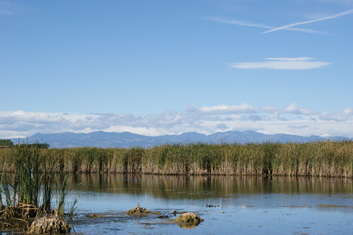
There's a buffalo herd in Denver, tucked between the airport and downtown.
The Rocky Mountain Arsenal National Wildlife Refuge was once a toxic blot on the northeastern outskirts of the city. Now it's a place to get away from it all in the heart of Commerce City.
The toxicity kept everyone away -- except for the animals.
After the U.S. Army made all sorts of nasty weapons here from the 1940s, including Sarin nerve gas, one of the most horrifying compounds ever made by man, until shutting the site down in 1992. At that point the Environmental Protection Agency stepped in to oversee the cleanup of a seriously toxic brew of organochloride, carbamate, and other poisons.
It was one of the largest and most infamous Superfund sites in the country and it required nearly 20 years to finish the job. As of 2010, the Army had transferred all 27 square miles of the former Arsenal to the U.S. Fish and Wildlife Service.
But the long absence of human activity here made it perfect for 330 species that call the place home, including bald eagles, mule deer, coyotes, bullfrogs, snapping turtles, and plenty of catfish and bass.
The U.S. Fish and Wildlife Service transferred a few bison here from Montana and they thrived. The herd was culled in 2013 after hitting a population of nearly 90 in order to protect the fragile prairie -- each of the shaggy beasts grazes its way through a ton of grass a month, give or take.
I didn't spot any buffalo when I visited last month. My wife, Jamie, and I drove the nine-mile loop and saw raptors and a mule deer resting in the tall grass of what seemed like an untouched patchwork of prairie, forest, and wetlands. Despite the place's legacy, it struck me as pristine, how Denver looked before the city took root in in 1858 and mushroomed to 100,000 people before the turn of the 20th century.
After driving most of the loop, hiked around Ladora Lake for a couple miles. There are over 10 miles of trails in all and I'm planning on wandering down more of them soon.
Best of all, there was almost nobody there on that particular Tuesday. We spotted only a few fisherman in the lake, but no other pedestrians on the trail. The refuge sees nearly 300,000 visitors a year, but with 17,000 acres of land, don't expect too many crowds.
The spectacular views of the Rockies and downtown, unobstructed by telephone lines and other urban detritus, were a nice alternative to our usual weekly trip up I-70 or U.S. 285 to hike the Rockies -- and we only had to drive 10 minutes past downtown Denver to see them.
Eric Peterson, Oct. 9, 2014
The Rocky Mountain Arsenal National Wildlife Refuge was once a toxic blot on the northeastern outskirts of the city. Now it's a place to get away from it all in the heart of Commerce City.
The toxicity kept everyone away -- except for the animals.
After the U.S. Army made all sorts of nasty weapons here from the 1940s, including Sarin nerve gas, one of the most horrifying compounds ever made by man, until shutting the site down in 1992. At that point the Environmental Protection Agency stepped in to oversee the cleanup of a seriously toxic brew of organochloride, carbamate, and other poisons.
It was one of the largest and most infamous Superfund sites in the country and it required nearly 20 years to finish the job. As of 2010, the Army had transferred all 27 square miles of the former Arsenal to the U.S. Fish and Wildlife Service.
But the long absence of human activity here made it perfect for 330 species that call the place home, including bald eagles, mule deer, coyotes, bullfrogs, snapping turtles, and plenty of catfish and bass.
The U.S. Fish and Wildlife Service transferred a few bison here from Montana and they thrived. The herd was culled in 2013 after hitting a population of nearly 90 in order to protect the fragile prairie -- each of the shaggy beasts grazes its way through a ton of grass a month, give or take.
I didn't spot any buffalo when I visited last month. My wife, Jamie, and I drove the nine-mile loop and saw raptors and a mule deer resting in the tall grass of what seemed like an untouched patchwork of prairie, forest, and wetlands. Despite the place's legacy, it struck me as pristine, how Denver looked before the city took root in in 1858 and mushroomed to 100,000 people before the turn of the 20th century.
After driving most of the loop, hiked around Ladora Lake for a couple miles. There are over 10 miles of trails in all and I'm planning on wandering down more of them soon.
Best of all, there was almost nobody there on that particular Tuesday. We spotted only a few fisherman in the lake, but no other pedestrians on the trail. The refuge sees nearly 300,000 visitors a year, but with 17,000 acres of land, don't expect too many crowds.
The spectacular views of the Rockies and downtown, unobstructed by telephone lines and other urban detritus, were a nice alternative to our usual weekly trip up I-70 or U.S. 285 to hike the Rockies -- and we only had to drive 10 minutes past downtown Denver to see them.
Eric Peterson, Oct. 9, 2014